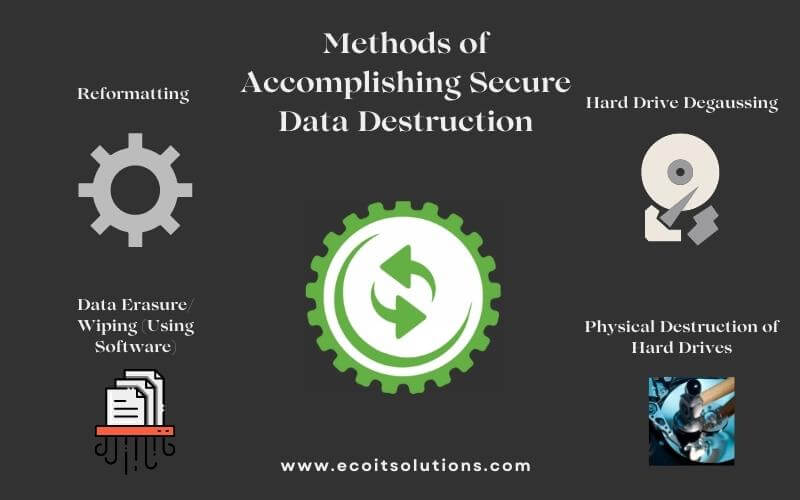Exploring the Significance of Data Destruction in the Context of Computer System Security Services and Protecting Confidential Data
In an era where data breaches are increasingly common, the value of reliable data damage can not be overemphasized. When no much longer necessary, Organizations must take on rigorous actions to make certain that delicate information is not just shielded throughout its lifecycle however also emphatically eliminated. The methods used for data eradication, paired with conformity to legal criteria, play a critical function in preserving privacy and trust fund. The implications of these techniques extend past simple conformity, influencing a firm's track record and functional stability in the digital industry. What approaches can companies execute to improve their information destruction procedures?
Understanding Data Damage
Information devastation is an important part of computer protection that involves the permanent removal of information from storage gadgets to avoid unauthorized gain access to and possible data breaches. In an increasingly digital landscape, companies encounter heightened risks connected with delicate details being poorly accessed or exploited. Effective data destruction safeguards versus these threats, making sure that private dataâEUR" such as consumer details, copyright, and economic recordsâEUR" can not be recouped after disposal.
Understanding the importance of data destruction extends beyond mere compliance with regulative and legal frameworks; it is necessary for preserving organizational integrity and trust. When information is poorly handled or improperly damaged, the repercussions can be serious, including financial loss, reputational damage, and lawful liabilities.

Methods of Information Removal

One widespread method is data wiping, which involves overwriting existing data with random patterns numerous times. This technique renders the original data irretrievable, making it a popular choice for organizations looking for to protect confidential information.
One more technique is degaussing, which uses a powerful magnetic area to interrupt the magnetic domain names on storage space gadgets, effectively getting rid of the information. This strategy is especially efficient for magnetic media yet is not applicable to solid-state drives.
Physical damage is another robust technique, squashing or including the shredding of storage space tools. This approach assurances that information healing is practically difficult, making it optimal for extremely sensitive details.
Finally, file encryption can act as a complementary approach to information elimination. By encrypting data before deletion, companies can include an extra layer of safety, guaranteeing that also if residues are recovered, they continue to be hard to reach without the decryption secret. Each technique should be picked based on the degree of data sensitivity and the details protection demands of the organization.
Legal Conformity and Data Safety And Security
Organizations should navigate a complicated landscape of legal demands associated with information safety and security, specifically after executing techniques of data elimination. Various laws, such as the General Data Defense Regulation (GDPR) and the Wellness Insurance Coverage Mobility and Accountability Act (HIPAA), enforce stringent standards on just how companies must get rid of and deal with of delicate data. Failure to abide with these policies can cause substantial legal effects, including significant penalties and reputational damage.
Data devastation processes should be diligently documented to demonstrate conformity with applicable laws and requirements. This paperwork not just serves as proof of adherence to lawful obligations however likewise highlights a dedication to safeguarding sensitive information. Organizations ought to likewise establish clear visite site policies regarding data retention and damage timelines, making sure that information is not held longer than needed.

Furthermore, routine audits and evaluations of data destruction techniques are vital to keep conformity and adapt to progressing lawful frameworks (data destruction). By proactively addressing lawful demands, organizations can mitigate threats associated with information violations and demonstrate their dedication to information safety. Ultimately, focusing on lawful conformity in data devastation procedures is not just a governing responsibility, however an essential aspect of a durable data security approach
Influence On Company Credibility
The credibility of an organization can be significantly influenced by its strategy to data destruction and management. In today's digital landscape, where data violations can occur at any kind of moment, the failing to correctly get rid of delicate info can bring about serious effects. Organizations that inadequately manage information destruction danger revealing confidential client information, which not only violates privacy regulations but likewise deteriorates trust amongst stakeholders and customers.
A tarnished online reputation can lead to reduced customer loyalty, as customers come to be hesitant to involve with a service that has actually demonstrated neglect in safeguarding their information. Negative promotion surrounding an information violation can have a long-term result, as potential customers might be discouraged by the regarded lack of security. This can result in a direct decline in profits and market share.
In addition, businesses that focus on information devastation as component of their security strategy can enhance their track record by showcasing their dedication data destruction to safeguarding sensitive information. By adopting stringent data management practices, organizations can not just minimize risks yet likewise position themselves as trustworthy entities in their corresponding sectors, consequently strengthening their overall brand name picture.

Finest Practices for Secure Disposal
Carrying out best techniques for safe disposal of Homepage data is essential for minimizing dangers connected with data violations and making sure compliance with personal privacy policies. Organizations needs to embrace an extensive data disposal plan that describes procedures for both electronic and physical information destruction.
For physical information storage tools, such as hard drives, shredding or degaussing is advised to avoid information healing. In addition, organizations ought to keep a chain of safekeeping documents during the disposal procedure, making sure responsibility and traceability of disposed things.
For digital information, using software program that adheres to sector standards for information wiping is crucial. This software program should overwrite existing data several times, making recuperation virtually impossible. It is likewise vital to verify the performance of the data damage procedure via audits or third-party evaluations.
Educating staff members on secure disposal methods adds one more layer of security, as human error can usually cause information direct exposure. On a regular basis assessing and updating disposal policies guarantees positioning with progressing laws and technical developments. By executing these finest methods, organizations can substantially minimize the threat of unapproved information accessibility and enhance their overall data protection strategy.
Conclusion
To conclude, data damage is a fundamental aspect of computer safety solutions that makes certain the defense of secret information from unauthorized access. Implementing effective methods of data elimination, adhering to legal conformity, and recognizing the impact on business credibility are important components of a comprehensive data security approach. By embracing best techniques for safe and secure disposal, organizations can foster trust fund with customers and protect sensitive data, inevitably adding to a more safe and secure electronic landscape.
In an era where information violations are progressively typical, the significance of reliable data damage can not be overemphasized.Data devastation is a crucial component of computer safety that entails the permanent elimination of data from storage space tools to protect against unauthorized accessibility and potential information violations. Organizations should additionally establish clear plans concerning data retention and destruction timelines, ensuring that data is not held longer than required.
By proactively dealing with lawful requirements, companies can mitigate threats associated with information breaches and demonstrate their commitment to information protection (data destruction). Ultimately, prioritizing legal conformity in information devastation processes is not just a regulatory obligation, but a basic element of a durable data security method